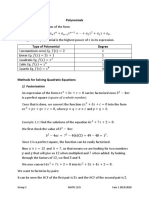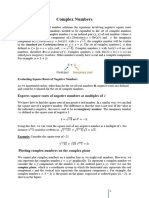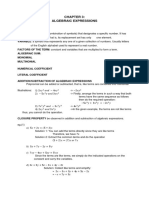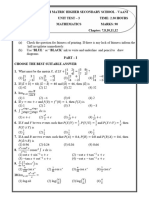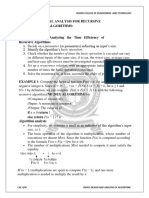304 Tutorial Note 1
Uploaded by
Stu Ungar304 Tutorial Note 1
Uploaded by
Stu UngarMATH304 Complex Analysis (2011 Spring)
Tutorial Note 1 Feb 14, 2011 (Week 2)
MATH304 Complex Analysis Tutorial Note 1 TA: Office: Email: Phone Number: Office Hours: CHENG, Kam Hang Henry 3215 (Lift 21) kero@ust.hk 2358 7468 / 9853 8144 Wed 15:00 17:00 Tutorial Sessions: T1A Mon 15:30 16:20 @ 4006 (4) T1B Mon 13:30 14:20 @ 4504 (25-26) T1C Mon 18:00 18:50 @ 4503 (25-26)
Topics covered in week 1: 1. The Field (, +,) of Complex Numbers 2. The Complex Plane 1. The Field (, +,) of Complex Numbers What you need to know: The ordered pair definition of a complex number, addition and multiplication 2 = 1 The 11 field axioms: Closure, commutativity and associativity of addition and multiplication Existences of additive and multiplicative identities and inverses Distributive laws To show that (, +,) satisfies all the 11 field axioms and other field properties, e.g. the (left or right) cancellation law
To verify the field axioms for , we need to use the ordered pair definition. We can always use the fact that is a field. Example 1.1 Prove that the multiplication on is commutative.
Multiplication on is commutative.
Proof: For any two complex numbers 1 = (, ) and 2 = (, ), we have 1 2 = (, ) (, ) = ( , + ) = ( , + ) = (, ) (, ) = 2 1 So the multiplication on is commutative.
Page 1 of 9
MATH304 Complex Analysis (2011 Spring)
Tutorial Note 1 Feb 14, 2011 (Week 2)
Example 1.2
Prove that the right distributive law holds on .
Proof: For any three complex numbers 1 = (, ), 2 = (, ) and = (, ), we have (1 + 2 ) = ((, ) + (, )) (, ) We have used the right = ( + , + ) (, ) = (( + ) ( + ), ( + ) + ( + )) = ( + , + + + ) = ( , + ) + ( , + ) = (, ) (, ) + (, ) (, )
distributive law on .
= 1 + 2 So the right distributive law holds for (, +,). 2. The Complex Plane What you need to know: Definitions and properties of the real part Re , the imaginary part Im the modulus ||, the (principal) argument Arg , arg , and the complex conjugate of a complex number To convert any given complex number into its standard form + , polar form (cos + sin ), and Euler exponential form The triangle inequalities ||| ||| | + | || + || De Moivres Theorem, th roots of unity (1) Applications of De Moivres Theorem and th roots of unity: To find the th roots of a complex number To prove certain trigonometric identities Geometric interpretation of complex numbers, equations of curves on
Imaginary axis
Re( ) = 2 2 Real axis
Page 2 of 9
MATH304 Complex Analysis (2011 Spring)
Tutorial Note 1 Feb 14, 2011 (Week 2)
First we need to know how to express complex numbers in their various different forms. Example 2.1 Solution: (i) We have |2 + 3| = (2)2 + 32 = 13. Since 2 + 3 lies in Quadrant II, we have arg(2 + 3) + tan1 2 = tan1 2. So, 2 + 3 = 13 (tan
1 3)
Express the complex numbers 2 + 3 and 1 cos sin (0 2) in Eulers exponential form.
(ii) We have |1 cos sin | = (1 cos )2 + (sin )2 = 2 2 cos . Since 1 cos 0, 1 cos sin must lie inside the closed right half plane. If = 0 or = 2, then 1 cos sin = 0. If 0 < < 2, then we have
sin 1cos
2 sin cos
2 2 2 sin2 2
= cot 2 = tan ( 2 2 ), which
2
gives arg(1 cos sin ) 2 2 . (Why not So in both cases,
+ 2 ?)
( ) 2 2
1 cos sin = 2 2 cos
When dealing with the real and imaginary parts of , the standard form of is useful. Example 2.2 Proof: For any complex number , we write = + . Then | 1| < | + 1| | + 1| < | + + 1| ( 1)2 + 2 < ( + 1)2 + 2 2 2 + 1 + 2 < 2 + 2 + 1 + 2 > 0 Re > 0 Show that Re > 0 if and only if | 1| < | + 1|.
Page 3 of 9
MATH304 Complex Analysis (2011 Spring)
Tutorial Note 1 Feb 14, 2011 (Week 2)
On the other hand, the polar form or the Euler exponential form of are of course more useful when dealing with the modulus and the argument of . Example 2.3 Show that if 1 , 2 and 3 are distinct complex numbers such that |1 | = |2 | = |3 |, then arg 3 2 = arg 2. 2
3 1 1
Proof: If |1 | = |2 | = |3 | = 0, then we must have 1 = 2 = 3 = 0 and they are not distinct. So we let |1 | = |2 | = |3 | = > 0, and write = ( + ) for = 1,2,3, where (, ) are distinct. Then, 3 2 arg 3 1 = arg = arg (cos 3 + sin 3 ) (cos 2 + sin 2 ) (cos 3 + sin 3 ) (cos 1 + sin 1 ) (cos 3 + sin 3 ) (cos 2 + sin 2 ) (cos 3 + sin 3 ) (cos 1 + sin 1 ) 2 sin
3 + 2 3 2 + + 2 cos 3 2 2 sin 3 2 2 2 sin 2 = arg + 1 1 + 1 1 2 sin 3 sin 3 + 2 cos 3 sin 3 2 2 2 2 + + 2 sin 3 2 2 sin 3 2 2 + cos 3 2 2 = arg ( ) 3 1 3 + 1 3 + 1 2 sin 2 sin 2 + cos 2 sin 3 2 2 3 + 2 3 + 2 3 + 1 3 + 1 = arg * ( sin + cos ) ( sin cos )+ 2 2 2 2 sin 3 2 1 sin 3 2 2 2 1 2 1 = arg * (cos + sin )+ 3 1 2 2 sin 2 2 1 ={ + : } (Why not + 2?) 2 1 2 = arg 2 1 Question: What is the geometric meaning of this result? (For two points on a circle, the angle at center is twice of any angle at circumference.)
Page 4 of 9
MATH304 Complex Analysis (2011 Spring)
Tutorial Note 1 Feb 14, 2011 (Week 2)
Here are some useful properties of the modulus and the complex conjugate: = = = ( )= Example 2.4 Proof: We have | + |2 = ( + )( + ) = ( + )( + = + + + ) = + + ( + ) 2 2 = || + || + 2 Re | |2 = ( )( ) = ( )( = + ) = + ( + ) = ||2 + ||2 2 Re So summing up we get | + |2 + | |2 = 2(||2 + ||2 ) The triangle inequalities ||| ||| | + | || + || are very useful inequalities that give upper and lower bounds to the moduli of complex numbers. It is very frequently used in many areas, especially analysis. Example 2.5 (Gamelin I.2.7 adapted) Suppose > 1, 0 and 1. Prove that
|| = |||| || | |= ||
= ||2 + = 2Re() = 2Im()
(Conway I.2.4) Suppose that and are complex numbers. Prove that | + |2 + | |2 = 2(||2 + ||2 ).
for any on the circle || = , we always have | +1| 1. Proof: On the circle || = , we have | + 1| || | 1| = 1 by the triangle inequality. So we always have | | | | = | + 1| + 1 1
Page 5 of 9
Since > 1 we have | 1| = 1.
MATH304 Complex Analysis (2011 Spring)
Tutorial Note 1 Feb 14, 2011 (Week 2)
To find the th roots of a given complex number , we usually express either in polar form or Euler exponential form and then apply De Moivres Theorem. Dont forget your . Example 2.6 Find the square roots of 1 3. Solution: In polar form, we have
Make sure that in the
1 3 polar form or exponential form. 1 3 = 2 . / 2 2 = (cos ( ) + sin ( )) 3 3 Therefore by De Moivres Theorem, (1 3) = ,2 (cos
1 2
3 + 2
+ sin
3 + 2
) : = 0,1-
= ,2 (cos ( ) + sin ( )) : = 0,16 6 5 5 = {2 *cos ( ) + sin ( )+ , 2 [cos ( ) + sin ( )]} 6 6 6 6
When is a real number, there is no difference between and for and , \*0+. But now when is a complex number, there is sometimes a subtle difference between (the sets) and for and , \*0+.
1 4
Example 2.7
Find the values of (cos
2 3
2 2 sin 3 )
and of (cos
2 3
2 8 sin 3 ) .
Solution: (i) By De Moivres Theorem,
1 2 2 + + 2 2 2 (cos + sin ) = ,cos 3 + sin 3 : = 0,13 3 2 2
= ,cos ( + ) + sin ( + ) : = 0,13 3 = {cos 4 4 + sin , cos + sin } 3 3 3 3
Page 6 of 9
MATH304 Complex Analysis (2011 Spring)
4 1
Tutorial Note 1 Feb 14, 2011 (Week 2)
(ii) We should interpret (cos Since (cos
2 3
2 3
2 8 sin 3 ) 8 3
as [(cos
8 3
2 3
+ sin
2 4 8 3
) ].
+ sin
2 4 3 4
) = cos
+ sin
, we have
1
2 2 8 8 8 8 (cos + sin ) = (cos + sin ) 3 3 3 3 8 8 3 + + sin 3 + : = 0,1,2,3,4,5,6,7= ,cos 8 8 = {cos ( + ) + sin ( + ) : = 0,1,2,3,4,5,6,7} 3 4 3 4 To derive trigonometric identities involving an arbitrary angle, we may apply De Moivres Theorem and then compare the real parts or the imaginary parts of both sides of the equation. Example 2.8 Prove the identity cos 4 = 8 cos4 8 cos 2 + 1 for . Proof: De Moivres Theorem asserts that for any , cos 4 + sin 4 = (cos + sin )4
4 4 = (cos )4 ( sin ) =0
= (cos 4 6 cos2 sin2 + sin4 ) + (4 cos3 sin 4 sin3 cos ) Comparing the real parts of both sides, we get cos 4 = cos4 6 cos2 sin2 + sin4 = cos4 6 cos2 (1 cos 2 ) + (1 cos2 )2 = 8 cos 4 8 cos 2 + 1 for any .
Page 7 of 9
MATH304 Complex Analysis (2011 Spring)
Tutorial Note 1 Feb 14, 2011 (Week 2)
As for trigonometric identities involving integral multiples of certain special angles, we usually consider an equation related to the roots of unity.
2 4 2(1)
Example 2.9 Proof:
Prove that for any integer 2, cos
+ cos
+ + cos
= 1.
Given a positive integer , observe that = roots of the equation 1 = 0.
+ sin
, = 0,1, , 1 are the
If 2, then the coefficient of in this equation is zero. So the sum of roots gives 0 0 + 1 + + 1 = = 0 1 1 + + 1 = 0 = 1
1
(cos
=1 1
2 2 + sin ) = 1
1
=1
2 2 cos + sin = 1
=1 2
Comparing the real parts of both sides, we get 1 cos =1
= 1.
Equations in complex variables can be easily transformed into those in the 2-D Cartesian coordinate plane when we express complex variables in its standard form. Example 2.10 (Brown & Churchill 5.2a) equation Re( ) = 2. Solution: Writing = + , we have = . So the equation becomes Re( ) = 2 Re( ( + 1)) = 2 = 2 Therefore the given equation determines the vertical line = 2 in the Cartesian coordinate plane.
2 Re( ) = 2
Sketch the set of points determined by the
Page 8 of 9
MATH304 Complex Analysis (2011 Spring)
Tutorial Note 1 Feb 14, 2011 (Week 2)
Exercise 1. Check that , equipped with addition and multiplication, satisfies all the field axioms. 2. Show that for any two complex numbers and , if = 0 then = 0 or = 0. Remark: This is the integral domain property of . 3. (Mid-term 2008 Spring) Prove the following statements. (a) If 2 = 2 , then is either real or purely imaginary. (b) If is on the circle || = 2, then | 4 4 2 +3| 3. 4. (Nevanlinna & Paatero 1.10) Suppose that and are complex numbers such that 1. Prove that if either || = 1 or || = 1, then |1 | = 1. 5. Find the cube roots of 5 + 5. 6. (Conway I.4.7) If is a complex number such that Re 0 for any positive integer , show that is a non-negative real number. 7. Prove that for any integer 2, sin sin
2 1 1
sin
(1)
= 21.
[Hint: Consider the equation ( + 1) 1 = 0.] 8. (Brown & Churchill 5.2b) Sketch the set of points determined by the equation |2 + 2| = 4.
Page 9 of 9
You might also like
- Olympiad Champs Mathematics Class 5 With Past Olympiad Questions 3rd Edition - Nodrm PDF92% (12)Olympiad Champs Mathematics Class 5 With Past Olympiad Questions 3rd Edition - Nodrm PDF240 pages
- Practice Problems Exam 2, Spring 2018 Solutions: Harmonic FunctionsNo ratings yetPractice Problems Exam 2, Spring 2018 Solutions: Harmonic Functions12 pages
- Termpaper-Bessel's Differential Equations, Legendre's Polynomial, Rodrigues Formula and Generating Function-MathNo ratings yetTermpaper-Bessel's Differential Equations, Legendre's Polynomial, Rodrigues Formula and Generating Function-Math10 pages
- Mathematics- Differential Calculus trigonometryNo ratings yetMathematics- Differential Calculus trigonometry18 pages
- Calculus & Vector Analysis (assignment)No ratings yetCalculus & Vector Analysis (assignment)11 pages
- Complex Analysis Problems With SolutionsNo ratings yetComplex Analysis Problems With Solutions88 pages
- Concourse 18.03 - Lecture #5: Dy DX Dy DXNo ratings yetConcourse 18.03 - Lecture #5: Dy DX Dy DX4 pages
- Lecture 1.2 Complex Numbers - OperationsNo ratings yetLecture 1.2 Complex Numbers - Operations4 pages
- Complex Numbers in Polar Form and DeMoivres TheoremNo ratings yetComplex Numbers in Polar Form and DeMoivres Theorem16 pages
- De Moiver's Theorem (Trigonometry) Mathematics Question BankFrom EverandDe Moiver's Theorem (Trigonometry) Mathematics Question BankNo ratings yet
- Single National Curriculum: Lead Trainer OF MathematicsNo ratings yetSingle National Curriculum: Lead Trainer OF Mathematics16 pages
- DM's Esoteric Programming Languages - Piet - CopyNo ratings yetDM's Esoteric Programming Languages - Piet - Copy1 page
- Math - Gr6 - Q1 - Module 05-L2 - Multiplying-Decimals-Mentally-up-to-2-Decimal-Places-by-0.1-0.01-10-100-1-1-1No ratings yetMath - Gr6 - Q1 - Module 05-L2 - Multiplying-Decimals-Mentally-up-to-2-Decimal-Places-by-0.1-0.01-10-100-1-1-112 pages
- Ucmas - 11th All India Competition - Circular - Karnataka StateNo ratings yetUcmas - 11th All India Competition - Circular - Karnataka State12 pages
- Ncert Solutions Class 8 Math Chapter 1 Rational NumbersNo ratings yetNcert Solutions Class 8 Math Chapter 1 Rational Numbers18 pages
- Calculus in India: The Historical and Mathematical Context: P. P. DivakaranNo ratings yetCalculus in India: The Historical and Mathematical Context: P. P. Divakaran7 pages
- VII-CBSE-Mathematics - 1 Integers (Notes) WMNo ratings yetVII-CBSE-Mathematics - 1 Integers (Notes) WM13 pages
- Computer Architecture and Organization: The CpuNo ratings yetComputer Architecture and Organization: The Cpu29 pages
- A Detailed Lesson Plan in Math For Grade 3No ratings yetA Detailed Lesson Plan in Math For Grade 39 pages
- Mathematics7 - q1 - Mod3 - Intergers and Absolute Value - V5No ratings yetMathematics7 - q1 - Mod3 - Intergers and Absolute Value - V540 pages
- Maths - Positive and Negative Integers Chapter 12No ratings yetMaths - Positive and Negative Integers Chapter 1236 pages
- Bahay Pare National High School: Department of Education Region III Division of Pampanga CandabaNo ratings yetBahay Pare National High School: Department of Education Region III Division of Pampanga Candaba2 pages
- Olympiad Champs Mathematics Class 5 With Past Olympiad Questions 3rd Edition - Nodrm PDFOlympiad Champs Mathematics Class 5 With Past Olympiad Questions 3rd Edition - Nodrm PDF
- Practice Problems Exam 2, Spring 2018 Solutions: Harmonic FunctionsPractice Problems Exam 2, Spring 2018 Solutions: Harmonic Functions
- Termpaper-Bessel's Differential Equations, Legendre's Polynomial, Rodrigues Formula and Generating Function-MathTermpaper-Bessel's Differential Equations, Legendre's Polynomial, Rodrigues Formula and Generating Function-Math
- Complex Numbers in Polar Form and DeMoivres TheoremComplex Numbers in Polar Form and DeMoivres Theorem
- De Moiver's Theorem (Trigonometry) Mathematics Question BankFrom EverandDe Moiver's Theorem (Trigonometry) Mathematics Question Bank
- Single National Curriculum: Lead Trainer OF MathematicsSingle National Curriculum: Lead Trainer OF Mathematics
- Math - Gr6 - Q1 - Module 05-L2 - Multiplying-Decimals-Mentally-up-to-2-Decimal-Places-by-0.1-0.01-10-100-1-1-1Math - Gr6 - Q1 - Module 05-L2 - Multiplying-Decimals-Mentally-up-to-2-Decimal-Places-by-0.1-0.01-10-100-1-1-1
- Ucmas - 11th All India Competition - Circular - Karnataka StateUcmas - 11th All India Competition - Circular - Karnataka State
- Ncert Solutions Class 8 Math Chapter 1 Rational NumbersNcert Solutions Class 8 Math Chapter 1 Rational Numbers
- Calculus in India: The Historical and Mathematical Context: P. P. DivakaranCalculus in India: The Historical and Mathematical Context: P. P. Divakaran
- Mathematics7 - q1 - Mod3 - Intergers and Absolute Value - V5Mathematics7 - q1 - Mod3 - Intergers and Absolute Value - V5
- Bahay Pare National High School: Department of Education Region III Division of Pampanga CandabaBahay Pare National High School: Department of Education Region III Division of Pampanga Candaba
























